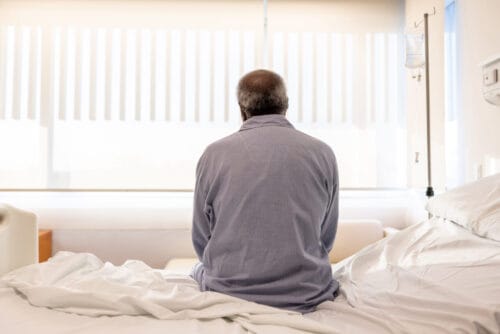
FG Trade, Getty Images
Historically marginalized communities are subject to delays across the spectrum of cancer care.
Cancer is a complex, often terrifying diagnosis for any patient. But when this diagnosis is compounded by poverty, structurally racist systems, and lack of access to transportation and affordable healthcare, the diagnosis is steeped in other fears. Chief among them is navigating the U.S. healthcare system, which is notoriously labyrinthine but even more unnavigable for those who have been historically marginalized.
This is where patient navigators come in.
Patient navigators are individuals (either administrative staff or medical professionals) who help guide patients through diagnosis, treatment, and follow-up appointments. BMC’s patient navigators themselves typically come from marginalized communities, making them uniquely able to empathize with patients who already feel ostracized from the health system. They assist with anything from setting up doctor’s visits to helping a patient work with their health insurance company.
Patient navigation, a concept that has been around since the 1980s, is linked to better health outcomes and patient satisfaction. It is, however, a notoriously underfunded program, with the burden of cost falling on health systems. Creating a sustainable model for patient navigation is an uphill battle, but a worthwhile one, when one looks not only at cost savings because of fewer appointment cancellations, but in providing more equitable healthcare to communities that have been traditionally marginalized.
Tracy Battaglia, MD, MPH, associate director of the Belkin Breast Health Center at Boston Medical Center (BMC) has over two decades of experience in designing and implementing patient navigation programs to reduce delays across the continuum of cancer care. She recently released a supplement with the American Cancer Society comprising 13 pieces of research about the efficacy of patient navigation in oncology care. HealthCity spoke to Battaglia about the history of patient navigation and how patient navigators are critical in closing racial inequities in cancer outcomes.
HealthCity: Let’s start with the history of patient navigation in this country.
Tracy Battaglia, MD, MPH: Harold Freeman, who’s called the grandfather of patient navigation, was a surgical oncologist in Harlem who started the first program and demonstrated improvements in stage and improvements in mortality in Harlem.
He worked with the American Cancer Society in the late 1980s, going around the country and interviewing individuals from marginalized communities. Through those interviews, Freeman and his team identified social barriers and social determinants of health issues — being poor, being uninsured, not having stable housing or a stable income, food insecurity, and racism, for example. Freeman used those findings to innovate a community-driven approach.
The notion of patient navigation is that, to close the gap between the available services and the patients in the community, you need a bridge. And that bridge is this lay navigator who can go out to the community, get the patients to come in, and support them through the healthcare process. It’s in addition to the healthcare team, and it’s become its health intervention.
HC: What are some of the biggest disparities that can impact cancer outcomes, especially for people of color and people from other marginalized groups like those with unstable housing?
TB: If you look at all the major cancer sites — breast, prostate, lung, colorectal — there is evidence that populations that are historically marginalized have worse outcomes. They have later stages of diagnosis and higher mortality rates despite lower incidents or prevalence. There are differences in tumor biology and risk factors at the genetic biologic level that are real. But there’s plenty of evidence that suggests when all things are equal, outcomes could be the same, but they are not.
We’ve been able to demonstrate repeatedly via local and national data that some of this is related to delays in care across the entire spectrum of cancer care. When it comes to breast cancer, if you look at Boston data and Massachusetts data, it’s young Black women who are dying more often. At the health system level, we need to be doing everything we can to make sure that they have access to care. And just because we have all these wonderful institutions in the city of Boston does not mean that they’re accessing care equally.
HC: That makes a lot of sense, unfortunately, if you think about the mistrust that is justified in so many of those communities. Especially Black communities.
TB: Absolutely. That’s at the heart of it, for sure.
HC: Talk us through how the patient navigator fits into the cancer care process once a patient has been diagnosed with, for example, breast cancer.
TB: The ideal model is that every patient that comes into the BMC health system who has a new diagnosis of cancer or a suspicion of cancer gets put into the navigation process.
The navigator does a systematic assessment to determine if you have any social needs that we know will interfere with care. If you screen positive in that initial assessment and/or have other risk factors — based on not having English proficiency, being uninsured, experiencing homelessness, or any other of these risk factors — you will get assigned a navigator.
Navigation begins from this screening and continues supporting patients across their care continuum until their survivorship and completion of treatment. Navigators make sure patients understand their treatment plan, identify things that are interfering with their ability to participate in that treatment plan, and connect them with resources — whether it be housing support, employment or disability support, income support, or food insecurity and helping them access healthy foods. Transportation is a huge one.
HC: What makes Boston Medical Center’s patient navigation program different?
TB: Our approach to navigation is that it’s not about a single navigator. We support navigation as a process. Every member of the cancer care team, whether it’s a nurse, front desk, social worker, or clinician, has a role in the navigation process, and the patient navigator is embedded into that care team. That’s the best practice that we’re trying to perpetuate.
HC: How does cultural competency or cultural humility come into play? I can imagine it’s hard for both a patient and provider to navigate cultural differences while centering respect and care for the patient.
TB: We’re really lucky at BMC because of our really sophisticated Interpreter Services program, which allows us to communicate with most people, regardless of the language they speak. And our navigation program historically aspires to have navigators who are from the community and either are linguistically, geographically or culturally congruent with portions of the population. BMC serves an incredibly diverse population, so it has been difficult to support every single culture or community, but we are always actively seeking ways we can recruit and train individuals from every community so we can continue to create an environment where we can meet the needs of different cultures and languages.
HC: What lies ahead in this work of patient navigation? What are some opportunities that could be built upon?
TB: The five-year aim for the National Navigation Roundtable is to develop a framework for sustainable navigation. Sustainability models rely upon reimbursement models. But there are other things that are necessary for sustainability, and that’s workforce development.
We do often see navigation positions as a stepping stone to move on to something else. So, we need to figure out how to create a sustainable workforce, and that means figuring out how to pay for it. We need to work with our policymakers, our insurers, and our health administrators to figure out different models. We’re talking with health system administrators about what their models of navigation look like and if they would be interested in participating in a pilot program that identifies best practices. It’s going to take all these different stakeholders that make up this complex health system at every level to come together to take this evidence that could create equity in outcomes and put it into place.
This interview has been edited and condensed.


